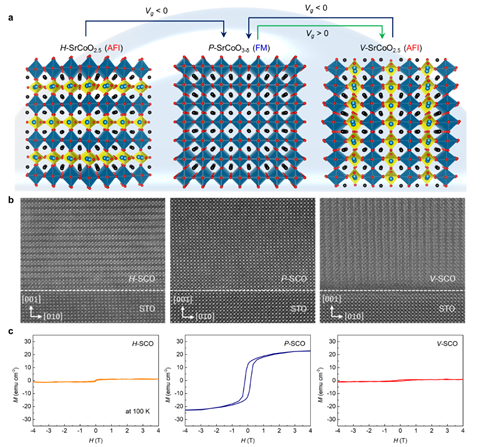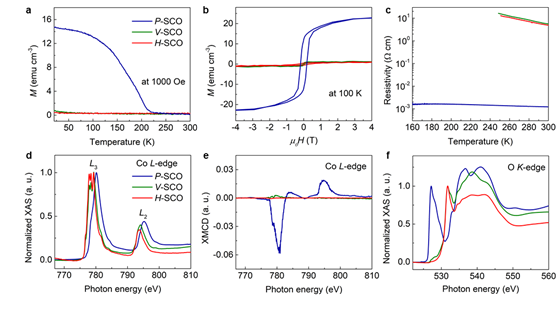Do you want to keep up to date? Subscribe to our newsletter. 1mail every 2months! |
 |
Cerdanyola del Vallès, 22nd April 2022 Oxygen vacancies lay an important role in determining the physical properties of many transition-metal oxides. The oxygen vacancies can give rise to phase transitions, for example between metallic and insulating states, and can significantly modify the electrical, magnetic, and optical properties. The oxygen vacancies also influence ionic transport that is key to the operation of devices for resistive switching and catalysis. In many cases, the oxygen vacancies form ordered arrays. An important example are the brownmillerite (BM) phases that are formed from the parent perovskite phase by the removal of oxygen in alternate layers. In these phases, oxygen vacancy channels (OVCs) are formed within the oxygen deficient layers. The OVCs can provide paths for fast ionic diffusion or storage of ions, leading to applications in fuel cells and rechargeable batteries. In addition, the OVCs affect the resistive switching response in memristors and strongly affect magnetic anisotropy.
In thin films, the OVCs can be formed either parallel or perpendicular to the substrate surface and thereby strongly influence the properties of the films. The OVC orientation can be affected by applying strain in thin films by suitable choice of the substrate on which the film is deposited, by the deposition conditions of the film growth, or by using an appropriate capping layer. However, all these methods are passive and cannot be employed to control the OVCs in films after they have been formed.
Now, a team from NISE department of Halle Max Planck Institute of Microstructure Physics has developed a method to electrically control the OVC ordering in thin layers of the exemplary oxide SrCoOx. This method uses ionic liquid gating (ILG), which has been shown to modify the properties of thin films of several transition-metal oxides by the electric field induced removal or insertion of oxygen into the film lattice. Scientists have used XAS & XMCD spectroscopy at the BOREAS beamline of ALBA to characterise the resulting changes in magnetic properties.
SrCoOx is a fascinating material. Whereas the parent perovskite SrCoO3-δ (P-SCO) is a ferromagnetic metal, brownmillerite SrCoO2.5 (BM-SCO) is an antiferromagnetic insulator. It has previously been shown that ILG of SrCoOx leads to a reversible transition between the BM-SCO and P-SCO phases. In this study, researchers demonstrate that antiferromagnetic BM-SrCoO2.5 with horizontal OVCs (H-SCO) can be transformed to the ferromagnetic perovskite phase (P-SCO) that has no OVCs, and that P-SCO can be transformed to BM-SCO with vertical OVCs (V-SCO) by ILG. Notably, these transformations are shown to be independent of strain induced in SrCoOx thin films by growing them on three distinct substrate materials.

Electrical control of oxygen vacancy ordering in SrCoOx thin films. a) Crystal structure of brownmillerite SrCoO2.5 having horizontal OVCs (H-SCO) (left), perovskite SrCoO3-δ (P-SCO) (center), and brownmillerite SrCoO2.5 having vertical OVCs (V-SCO) (right). The structure can be sequentially transformed by ionic liquid gating (ILG) at different gate voltages. b) STEM-HAADF images of H-SCO, P-SCO, and V-SCO (from left to right) grown on STO (001) substrates. c) Magnetization versus field curves for H-SCO, P-SCO, and V-SCO (from left to right) measured at 100 K.
This study opens a new avenue to tailor oxygen defects and electronic, magnetic, and optical properties of correlated oxide thin films and develop novel electric-field controlled oxitronic devices.
Max Planck group has grown epitaxial thin films and achieved the OVC control in thin films by using ILG. In particular, XAS/XMCD measurements at the BOREAS beamline were employed to resolve the magnetic properties with atomic sensitivity, and was important to reveal the distinct phase transitions between antiferromagnetic SrFeO2.5 and ferromagnetic SrFeO3-x thin films via ILG. The changes in chemical states of cobalt and oxygen were clearly identified.

Electronic and magnetic properties of three distinct SrCoOx films controlled by ILG. a) Temperature-dependent magnetization at 1000 Oe. b) Magnetization versus in-plane magnetic field at 100 K. c) Temperature dependent resistivity. d) Normalized XAS spectra in the vicinity of the Co L2,3 absorption edge. e) XMCD spectra recorded in remanence after applying an in-plane magnetic field of 6 T. f) Normalized XAS O K edge spectra. XAS and XMCD were recorded in grazing incidence.
Reference: H. Han, Arpit Sharma, H. L. Meyerheim, J. Yoon, H. Deniz, K.-R. Jeon, A. K. Sharma, K. Mohseni, C. Guillemard, M. Valvidares, P. Gargiani, S. S. P. Parkin. Control of oxygen vacancy ordering in brownmillerite thin films via ionic liquid gating. ACS Nano (2022) doi.org/10.1021/acsnano.2c00012
With the collaboration of Fundación Española para la Ciencia y la Tecnología. The ALBA Synchrotron is part of the of the Unidades de Cultura Científica y de la Innovación (UCC+i) of the FECYT and has received support through the FCT-20-15798 project.





